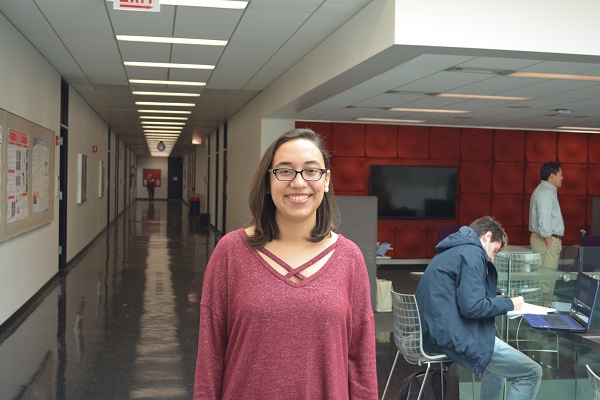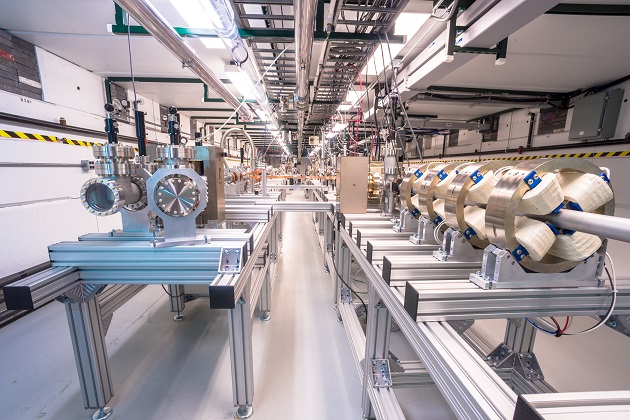Physics Ph.D. candidate Nicole Neveu researches next-generation particle accelerator technology at the Argonne Wakefield Accelerator (AWA) facility at Argonne National Laboratory. This fall, for three weeks, she participated in the “Adopt-a-Physicist” program led by physics honor society Sigma Pi Sigma.
Each night after finishing her research at AWA, Neveu would go home and get online to answer questions from sixth- and seventh-grade gifted students at Jewel Middle School in Aurora, Illinois, and ninth-graders at Oak Knoll High School in Summit, NJ: “What do you do at Argonne?” “How did you decide to be a physicist?” “What is the ratio of men to women at Argonne?”
One student asked, “Why don’t more people study physics?” To which Neveu replied, “Why do you think that is?”
“It turned into an interesting conversation,” she said. “I told them that in some ways you have to do a large amount of work before you get to the good parts of physics. You need a certain amount of knowledge before it’s interesting. But I tried to make the point that it can be interesting!”
“Nicole is a very talented, hardworking student,” said advisor Linda Spentzouris, professor of physics, who focuses on the role of accelerator component design and materials in beam dynamics of particle accelerators. She was an accelerator operator before earning her Ph.D. at Northwestern University, and then was a research associate at Fermilab.
“Nicole also has received a lot of support from the community,” Spentzouris continued. “She’s done really well.” Neveu was a teaching assistant for the Fundamentals of Accelerator Physics and Technology with Simulations and Measurements Lab class at the U.S. Particle Accelerator School. She received several financial awards to attend conferences, including the North American Particle Accelerator Conference and International Particle Accelerator Conference, and to take classes at USPAS. She also received an SCGSR award from the Department of Energy’s Office of Science Graduate Student Research program.
The focus of Neveu’s research at AWA so far has been the realization of fully-staged two-beam acceleration, a method whereby one electron beam helps to accelerate another, enabling more acceleration in a smaller space for a more compact accelerator. “The highest energy accelerator at CERN is a 27-kilometer machine,” Spentzouris noted. “One goal of accelerator research today is to make accelerators of a given energy smaller than they are now.” Neveu helps to get the AWA accelerator working better: She contributed to the design specification for the two-beam accelerator’s kicker, a device that moves the beam onto a different path, and she does myriad odd jobs such as tuning the laser pulses by adjusting the optics. She earned her undergraduate degree in electrical engineering from University of Houston and has found both engineering and physics backgrounds helpful in her research.
Lately, she has been doing beam measurements and simulations of the particle trajectories through the accelerator. She has implemented an optimizer in the simulation, the purpose of which is to find the configuration of accelerator run parameters that produces the highest quality particle beam. She is partnering with Jeffrey Larson, an assistant computational mathematician at Argonne whose research centers on optimization algorithms and their implementation in software.
“The faster you can run a simulation, the more possibilities you can cover,” Neveu said. “We want to have a better idea of how the machine will behave so we know what experiments it can do, how it will perform.”
As a result of her work on testing the OPAL (Object Oriented Particle Accelerator Library) simulation framework being developed at the Paul Scherrer Institut (PSI) in Switzerland, she was invited to travel to Switzerland and work with the developers, which she did in May 2017.
She has had the opportunity to learn from a number of Illinois Tech people in addition to Spentzouris, including Thomas Wong, professor of electrical and computer engineering, and alumni Wei Gai (PHYS Ph.D. ‘86), senior physicist and a group leader in the High Energy Physics (HEP) division at Argonne; John Power (PHYS Ph.D. ‘96), accelerator physicist, HEP division; and Chunguang Jing (EE Ph.D. ’05), vice president of engineering, and Sergey Antipov (PHYS Ph.D. ’07), director of radiation sources department, at EuclidLabs, an accelerator R&D company that frequently partners with Argonne.
Neveu hopes to finish up at the end of next summer and find a position in accelerator physics, at a research institute or laboratory, such as Los Alamos National Laboratory. “They’re talking about building a new accelerator there,” she said. “It’s my dream project, because not many places are building new accelerators.” After that, she may teach—answering more questions from students about physics, and what it’s like to be a physicist.

Nicole Neveu

AWA experimental area, two-beam acceleration. Photo courtesy of Scott Doran, Argonne National Laboratory.
